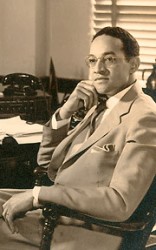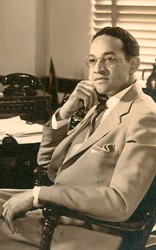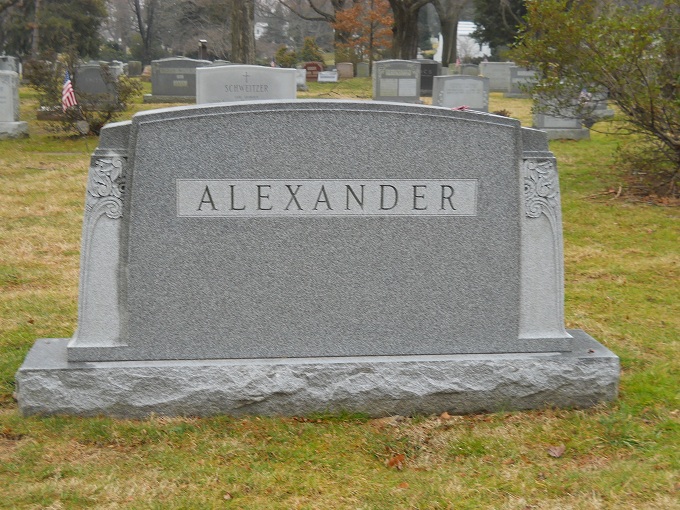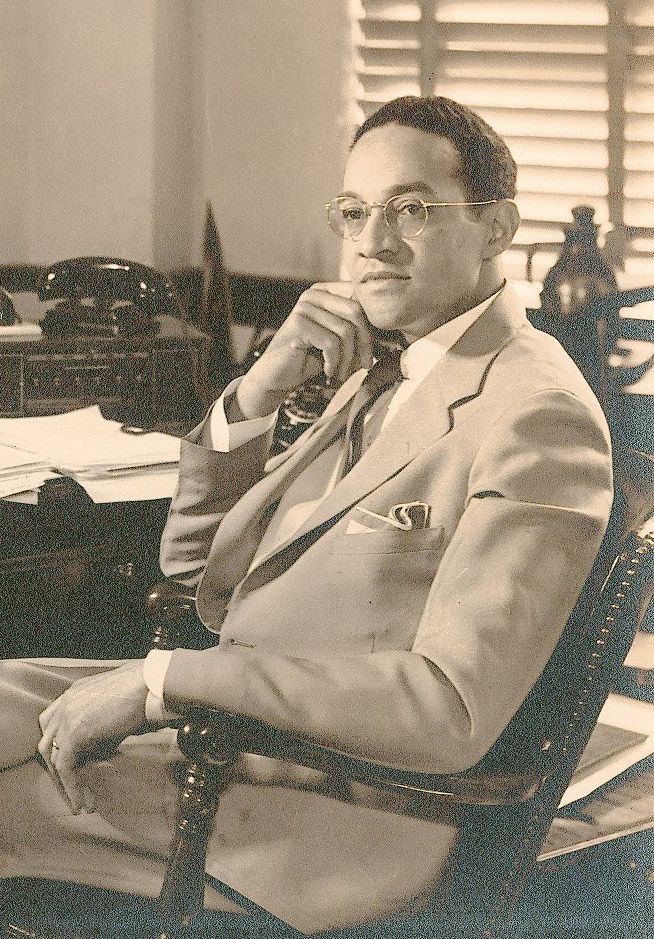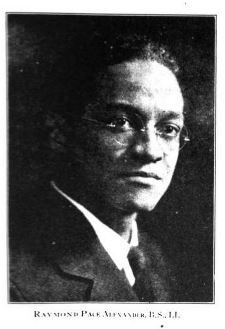Mr. Alexander's mother died shortly after the birth of his youngest sibling, and he was self-supporting from the age of twelve. As a boy he earned money by selling newspapers, working at a market, huckstering with a horse and wagon, working for the railroad and doing song and dance and summer stock theater at Pennsylvania and New Jersey resorts. He graduated from Central High School in 1917; entered the University of Pennsylvania in the fall of 1917; graduated from the Wharton School in 1920 and from Harvard Law School in June 1923.
Upon graduation, he returned to Philadelphia to undertake both his law practice and his battles against discrimination.
He was admitted to the Pennsylvania Bar and entered practice in August 1923, specializing in criminal law. He began his career in the office of John R.K. Scott, a successful trial lawyer.
In November, 1923, he married Sadie Tanner Mossell (January 2, 1898 - November 1, 1989), who was believed to have been the first black woman in the United States to receive a doctorate when she received her Ph.D. in economics from the University of Pennsylvania in 1922. Mrs. Alexander joined her husband's practice after she obtained her law degree in 1927.
In 1924, he was excluded from a Chestnut Street theater showing a movie "The Ten Commandments." He took the theater owners to court and won from them a pledge never to discriminate again.
In the late 'twenties, Raymond established his own offices in rented quarters on Chestnut Street, remaining there until 1935, when he moved into the new building he had built at 1900 Chestnut Street in Center City. Between 1924 and 1950, he served as an advocate in a number of important civil cases involving issues of racial discrimination and segregation in public accommodations. He was also a defense attorney in numerous criminal cases, many of which involved a racial aspect or civil rights issue. Some of his cases were highly sensational and his success in litigation brought him a great deal of publicity.
In the early 1930's, he took two Chester County school districts to court after they tried to establish racially segregated school systems. His victory in that case marked an end to de jure segregation in Pennsylvania schools.
Later in 1951, Judge Alexander single-handedly began the legal moves to end the exclusion of blacks from Girard college, efforts that were culminated more than 15 years later with a U.S. Supreme Court order to admits blacks to the college.
From 1949 to 1951, he was active in the Clark- Dilworth reform Democratic movement, supporting the Home Rule Charter for Philadelphia. In 1951, he won election to City Council under the new charter. He was re-elected to Council in 1955. From 1952 to 1956, he chaired the Committee on Recreation, and from 1956 to 1959, the Committee on Public Property and Public Works. In January, 1959, he was appointed to fill a vacancy on the Court of Common Pleas No. 4 by Governor George M. Leader. He was elected to a full ten-year term on the Court in the following November. After his term expired in 1970, he continued in the capacity of Senior Judge until his death in 1974.
Raymond Pace Alexander is a main character in George Cooper's 1999 book, "Poison Widows: A True Story of Witchcraft, Arsenic, and Murder." In this case, he became the first black lawyer in Philadelphia history to defend a white client successfully.
Mr. Alexander's mother died shortly after the birth of his youngest sibling, and he was self-supporting from the age of twelve. As a boy he earned money by selling newspapers, working at a market, huckstering with a horse and wagon, working for the railroad and doing song and dance and summer stock theater at Pennsylvania and New Jersey resorts. He graduated from Central High School in 1917; entered the University of Pennsylvania in the fall of 1917; graduated from the Wharton School in 1920 and from Harvard Law School in June 1923.
Upon graduation, he returned to Philadelphia to undertake both his law practice and his battles against discrimination.
He was admitted to the Pennsylvania Bar and entered practice in August 1923, specializing in criminal law. He began his career in the office of John R.K. Scott, a successful trial lawyer.
In November, 1923, he married Sadie Tanner Mossell (January 2, 1898 - November 1, 1989), who was believed to have been the first black woman in the United States to receive a doctorate when she received her Ph.D. in economics from the University of Pennsylvania in 1922. Mrs. Alexander joined her husband's practice after she obtained her law degree in 1927.
In 1924, he was excluded from a Chestnut Street theater showing a movie "The Ten Commandments." He took the theater owners to court and won from them a pledge never to discriminate again.
In the late 'twenties, Raymond established his own offices in rented quarters on Chestnut Street, remaining there until 1935, when he moved into the new building he had built at 1900 Chestnut Street in Center City. Between 1924 and 1950, he served as an advocate in a number of important civil cases involving issues of racial discrimination and segregation in public accommodations. He was also a defense attorney in numerous criminal cases, many of which involved a racial aspect or civil rights issue. Some of his cases were highly sensational and his success in litigation brought him a great deal of publicity.
In the early 1930's, he took two Chester County school districts to court after they tried to establish racially segregated school systems. His victory in that case marked an end to de jure segregation in Pennsylvania schools.
Later in 1951, Judge Alexander single-handedly began the legal moves to end the exclusion of blacks from Girard college, efforts that were culminated more than 15 years later with a U.S. Supreme Court order to admits blacks to the college.
From 1949 to 1951, he was active in the Clark- Dilworth reform Democratic movement, supporting the Home Rule Charter for Philadelphia. In 1951, he won election to City Council under the new charter. He was re-elected to Council in 1955. From 1952 to 1956, he chaired the Committee on Recreation, and from 1956 to 1959, the Committee on Public Property and Public Works. In January, 1959, he was appointed to fill a vacancy on the Court of Common Pleas No. 4 by Governor George M. Leader. He was elected to a full ten-year term on the Court in the following November. After his term expired in 1970, he continued in the capacity of Senior Judge until his death in 1974.
Raymond Pace Alexander is a main character in George Cooper's 1999 book, "Poison Widows: A True Story of Witchcraft, Arsenic, and Murder." In this case, he became the first black lawyer in Philadelphia history to defend a white client successfully.
Family Members
Sponsored by Ancestry
Advertisement
Records on Ancestry
Advertisement
